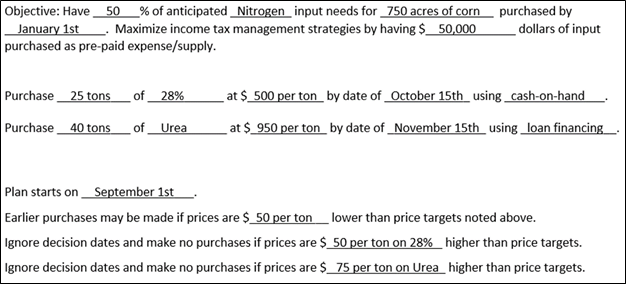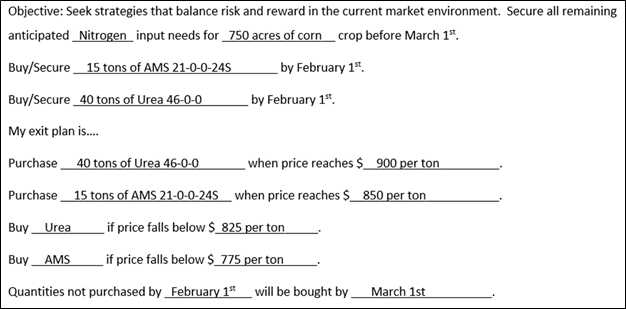
Input Purchasing Plan Template (Word)
DOWNLOADOctober 29, 2022 - Jonathan LaPorte, MSU Extension
Input purchasing starts with your farm’s cropping plan. These crop plans look at acres, yield goals, nutrient needs, and pest concerns. Most importantly, they help define what products you will need to buy. An input purchasing plan takes your crop plan and adapts it into an efficient buying strategy to secure products at affordable costs.
Borrowing concepts from grain marketing, input purchasing focuses on being intentional and pro-active about buying decisions. Decisions include prioritizing use of on-farm storage, inputs with higher purchase amounts, potential supply risks and alternative product options. Most importantly, these plans help maximize available cash as you review buying opportunities.
A key question starting out is whether your approach to input purchasing is strategic or tactical?
Strategic vs. Tactical – A strategic plan focuses on purchasing inputs during the Fall season. With a longer period before planting, there are more opportunities to position input prices. Decisions are based on best value and long-term market indicators. A tactical plan focuses on purchases in Winter or Spring when less opportunities exist to position prices before planting. Decisions are responsive to market conditions and focus on securing remaining input needs.

Plan Goals – All plans must have realistic and reasonable goals. For buying inputs, a primary goal is to secure input needs at lowest possible costs. Additional goals may be to ensure flexibility for income tax management and secure portions of total input needs by a specific date. For example, 50% of nitrogen will be bought by January 1st and at least $50,000 of pre-paid expenses for income tax management.

Quantity Objectives – Each purchase has a set amount of product that moves total purchases closer to meeting plan goals. More purchases, with smaller quantities is recommended to spread out potential risk and continue to evaluate market conditions. If prices rise, you have secured some product at a lower value. If prices fall, you have invested a limited amount of cash at higher prices.
Pricing Targets – A target price is a value acceptable to buy at. Targets should be based on market expectations, starting with comparison prices from at least two retailers. Factor in available discounts to identify actual market offerings. Lastly, compare inputs to expected commodity prices to see if potential profits offset purchases. With a strategic plan, you can be more selective with pricing targets to gain bigger discounts. With tactical plans, it is difficult to be selective when you are closer to planting and need inputs.
Price Saving Tools – Price saving tools focus on financing, early cash or even quantity discounts. Financing options offer reduced interest rates or discounts on total dollars. Early cash and quantity discounts are offered in exchange for securing a portion of your input needs. In seed and chemical purchases, some price saving tools can be offered together. Most price savings tools are available in Fall, making them ideal for strategic purchasing plans.
Decision Deadlines – Deadlines keep plans moving forward. Working with pricing targets, these dates encourage you to buy inputs or wait. If prices meet targets at a deadline, make your planned purchase. If prices are above targets, don’t purchase and move on to your next decision deadline. A third option is to buy if prices are close, and availability is a concern. Pay attention to seasonal patterns and market changes to decide which option is best.

Entering Winter, as plans shift to a tactical focus, pricing targets continue to be important but securing inputs is now your top priority. Having an “exit date” ensures you complete your plan with all input needs secured.

The input purchasing plan is also available in a Microsoft Excel format. The MS Excel version is available at:
Alternative Version - Input Purchasing Plan Template (MS Excel)



 Print
Print Email
Email





